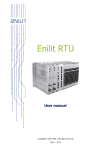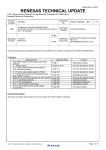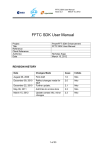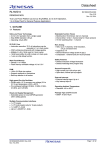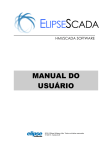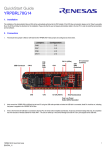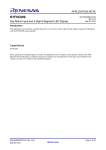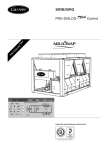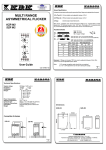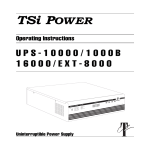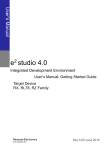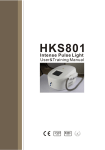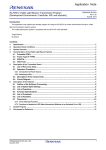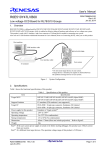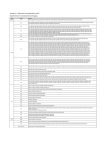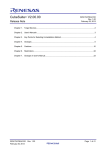Download RL78/G10 - Renesas Electronics
Transcript
APPLICATION NOTE RL78/G10 Multiplication and Division Program R01AN1976EJ0200 Rev. 2.00 Mar. 31, 2015 Introduction This application note explains the program which realizes multiplication and division of unsigned integer using RL78/G10. A program is shown about three kinds of arithmetic processing (16bit16bit, 16bit16bit32bit, and 32bit32bit). Target Device RL78/G10 When applying the sample program covered in this application note to another microcomputer, modify the program according to the specifications for the target microcomputer and conduct an extensive evaluation of the modified program. R01AN1976EJ0200 Rev. 2.00 Mar. 31, 2015 Page 1 of 13 RL78/G10 Multiplication and Division Program Contents 1. Specifications ................................................................................................................. 3 2. Operation Check Conditions ......................................................................................... 3 3. Description of Software ................................................................................................. 4 3.1 Operation Outline ........................................................................................................................ 4 3.2 The Way of Thinking of Multiplication ...................................................................................... 4 3.3 The Way of Thinking of Division................................................................................................ 4 3.4 Signed Data Handling ................................................................................................................. 6 3.5 List of Constants ......................................................................................................................... 6 3.6 List of Variables .......................................................................................................................... 7 3.7 List of Functions (Subroutine) ................................................................................................... 7 3.8 Function (Subroutine) Specifications ....................................................................................... 7 3.9 Flowcharts ................................................................................................................................... 9 3.9.1 Main Processing .................................................................................................... 9 3.9.2 Multiplication Processing of 16 Bits Data.......................................................... 10 3.9.3 Multiply and Accumulation Processing ............................................................. 11 3.9.4 Division Processing of 32 Bits ........................................................................... 12 4. Sample Code ................................................................................................................ 13 5. Documents for Reference ............................................................................................ 13 R01AN1976EJ0200 Rev. 2.00 Mar. 31, 2015 Page 2 of 13 RL78/G10 1. Multiplication and Division Program Specifications In this application note, an actual program and its usage are shown from the view of operation for three kinds of arithmetic processing subroutines (16bit16bit, 16bit16bit32bit, and 32bit32bit). Table 1.1 shows the arithmetic processing objected in this application note. Table 1.1 Targeted Arithmetic Processing Arithmetic Processing 16bit16bit 16bit16bit32bit 32bit32bit 2. Description Multiplication of unsigned integers of 16-bit data. Multiply and accumulation of unsigned integers of 16-bit data. The overflow flow is not detected from 32-bit data. The division processing of unsigned integers of 32-bit data. Operation Check Conditions The sample code described in this application note has been checked under the conditions listed in the table below. Table 2.1 Operation Check Conditions Item Microcontroller used Operating frequency Operating voltage Integrated development environment (CS+) Assembler (CS+) Integrated development environment (e2studio) Assembler (e2studio) Integrated development environment (IAR) Assembler (IAR) Operating environment R01AN1976EJ0200 Rev. 2.00 Mar. 31, 2015 Description RL78/G10 (R5F10Y16ASP) High-speed on-chip oscillator (HOCO) clock: 20 MHz CPU/peripheral hardware clock: 20 MHz 5.0 V (can run at a voltage range of 2.9 V to 5.5 V.) SPOR detection voltage: VSPOR = 2.90 V(TYP.)、VSPDR = 2.84 V(TYP.) When reset occurs: VDD < 2.84 V When reset is released: VDD 2.90 V CS+ for CA,CX V3.00.00 from Renesas Electronics Corp. RA78K0R V1.70 from Renesas Electronics Corp. e2studio V3.1.2.10 from Renesas Electronics Corp. KPIT GNURL78-ELF Toolchain V14.03 from Renesas Electronics Corp. IAR Embedded Workbench for Renesas RL78 V1.40.5 IAR Assembler for Renesas RL78 V1.40.5 RL78/G10 Simulator Page 3 of 13 RL78/G10 3. Multiplication and Division Program Description of Software 3.1 Operation Outline In the arithmetic processing of this application note, specified operation is performed to the data stored in the variable arranged to a short direct area, and the result is set to the variable arranged to the short direct area. 3.2 The Way of Thinking of Multiplication Calculation is performed by dividing large data into a small digit as well as the way of the usual computation on paper. In this case, attention is necessary for digit place (figure). Here, a calculation of hexadecimal numbers of A 1A2A3A4 x B1B2B3B4 is shown as an example. As the calculation method, the 8-bit multiply instruction "MULU X command" is used. Calculates in 4 steps of every 2 digits (8 bits) (multiplication); A1A2 × B1B2, A1A2 × B3B4, A3A4 × B1B2, A3A4 × B3B4, and 4 times of calculation results are added with attention to digit place. This system is shown in Figure 3.1. Thus, an answer can be obtained by adding in consideration of the digit of 4 times of calculation results. Here, although a multiplicand and a multiplier are 4 digits (16 bits), if they are beyond 4 digits (16 bits), they are calculable similarly by adding the calculation results of every double figure with attention to digit place. 1000000H digit 10000H digit 100H digit 1 digit Result of A3A4×B3B4 Result of A3A4×B1B2 Shift 8 bits Result of A1A2×B3B4 + Shift 8 bits Result of A1A2×B1B2 Higher 8 bits Upper middle 8 bits Shift 16 bits Lower middle 8 bits Lower 8 bits Figure 3.1 Data Scaling of 16 bits×16 bits 3.3 The Way of Thinking of Division RL78/G10 does not have a division command. Moreover, the multiplier and divider/multiply-accumulator circuit is not carried, either. Therefore, it is necessary to repeat subtraction processing in order to realize division. The simplest method is making a quotient the number of times that was able to subtract a divisor from a dividend. However, by such a simple method, processing time will be long. It is common to shorten the processing time by repeating subtraction for the number of the bits of the dividend while shifting a dividend by 1 bit. With division of 16 bits 16 bits as an example, this method is explained like below. R01AN1976EJ0200 Rev. 2.00 Mar. 31, 2015 Page 4 of 13 RL78/G10 Multiplication and Division Program (1) In order to execute division by repeating subtraction, the work area of the same bit length as a divisor is prepared at higher bits of a dividend and cleared by zero. (Refer to Figure 3.2) Work area The same bit length as a divisor (16 bits) 0 0 0 0 0 0 0 0 Dividend (16 bits) 0 B15 B14 B13 B12 B11 B4 B3 B2 B1 B0 」 0 Figure 3.2 Pre-preparation of Calculation (2) In subtraction processing, a dividend and work area is shifted 1 bit to the left at a time first as the preparation of subtraction. The MSB of dividend is set to the LSB of work area, and the LSB of dividend becomes 0. (Refer to Figure 3.3). The LSB of dividend is used as an area for the quotient in order to obtain the efficiency of processing and domain. Work area (16 bits) 0 0 0 0 0 0 Dividend (16 bits) 0 0 0 B15 B14 B13 B12 B11 B10 B3 B2 B1 B0 」 0 Figure 3.3 Preparation of subtraction (3) Whether a divisor is able to be subtracted from the work area is confirmed. If subtraction is possible, the quotient of the time becomes 1 and becomes 0 if impossible. This quotient is stored in LSB of a dividend (domain). The remainder at the time of being over is stored in work area. (Refer to Figure 3.4) Work area (16 bits) 0 0 0 0 0 0 Dividend (16 bits) 0 0 0 B15 B14 B13 B12 B11 B10 B3 B2 B1 B0 」 Subtraction Divisor 0 Quotient C15 C14 C13 C12 C11 C4 C3 C2 C1 C0 」 Remainder 0 0 0 0 0 0 0 0 0 X B14 B13 B12 B11 B10 B3 B2 B1 B0 A15 」 Figure 3.4 Execution of Subtraction The notes in this calculation are the column numbers of a quotient. After shifting a bit to the left, it subtracts and the quotient is certainly stored in LSB of a dividend area each time. And when both (2) and (3) are performed, the subtraction processing for 1 bit had completed. In the case of Figure 3.4, the quotient bit A15 stored in LSB of a dividend has bit weights of the 15th power of 2. Then, it is stored in the right (lower side) of A15 in order of lighter bit weights by repeating (2) and (3). (4) The work area and the dividend of a result which performed (2) and (3) for the following digits are shown in Figure 3.5. Work area (16 bits) Dividend (16 bits) 0 0 0 0 0 0 0 0 X X B13 B12 B11 B10 B9 B2 B1 B0 A15 A14 」 Figure 3.5 The Second Execution Result R01AN1976EJ0200 Rev. 2.00 Mar. 31, 2015 Page 5 of 13 RL78/G10 Multiplication and Division Program (5) The work area and dividend that are results of the 3rd shift and subtraction are shown in Figure 3.6. Work area (16 bits) 0 0 0 0 0 0 0 Dividend (16 bits) X X X B12 B11 B10 B9 B8 B1 B0 A15 A14 A13 Figure 3.6 The Third Execution Result (6) The work area and dividend that are results of having repeated the same shift and subtraction 16 times are shown in Figure 3.7. Here, a surplus is stored in work area and a quotient is stored in a dividend. Work area (16 bits) X X X X X X X Dividend (16 bits) X X X A15 A14 A13 A12 A11 A4 A3 A2 A1 A0 」 Figure 3.7 The 16th Execution Result Thus, when a dividend and a quotient share the same area, shift processing can also be shared and a program will be shorter. And since the command to execute decreases, the speed of processing can also be faster. Although the above example was a case of 16-bit data, the same view is made even if it is 32-bit data. 3.4 Signed Data Handling A sign is checked first in order to handle signed data for the multiplication and division. In the case of a negative number, after memorizing the sign to a flag, an absolute value is obtained by taking the complement of 2 to data. Arithmetic processing is performed in the obtained absolute value. The combination of the sign of two data is checked, and a result is made into a value with a sign if required. 3.5 List of Constants Table 3.1 lists the constants for the sample program. Table 3.1 Constants for the Sample Program Constant Setting Description DNMULC DNMUL DNRES DNdivS DNdivD DNQUO 16/8 16/8 DNMUL + DNMULC 32/8 32/8 DNdivD×8 The number of bytes of a multiplicand (16 bits) The number of bytes of a multiplier (16 bits) The number of bytes of the result area (32 bits) The number of bytes of a divisor (32 bits) The number of bytes of a dividend (32 bits) The number of times of calculation R01AN1976EJ0200 Rev. 2.00 Mar. 31, 2015 Page 6 of 13 RL78/G10 3.6 Multiplication and Division Program List of Variables Table 3.2 lists variables that are used in this sample program. Table 3.2 Variables for the Sample Program Description Multiplicand area/Lower part of divisor area Multiplier area/Upper part of divisor area Multiplication result area/Product-sum addition area/Dividend and quotient area Work and remainder area Variable Name RREG0 RREG1 RREG2 RREG3 3.7 List of Functions (Subroutine) Table 3.3 lists the functions that are used in this sample program. Table 3.3 List of Functions (Subroutine) Functions (Subroutine) Name M16bitX16bit M16bitA32bit D32bit_32bitS D32bit_32bitS2 3.8 Description Multiplication of 16-bit data (unsigned) 16-bit data is multiplied and the result is added to 32-bit data. (unsigned) Division of 32-bit data (unsigned, divisor checked) Division of 32-bit data (unsigned, no divisor check) Function (Subroutine) Specifications This section describes the specifications for the functions (subroutine) that are used in the sample program. [Function Name] M16bitX16bit Synopsis Explanation Arguments Return value Remarks Multiplication of 16-bit data (unsigned) Multiplies the multiplicand stored in RREG0 by multiplier stored in RREG1, and its result will be stored in RREG2. RREG0 Multiplicand (16 bits) RREG1 Multiplier (16 bits) RREG2 Product (32 bits) Registers to be used A, X, B, C Stacks to be used 4+4 bytes [Function Name] M16bitA32bit Multiplies 16-bit data by 16-bit data, and the result is added to 32-bit data. (unsigned) Synopsis Adds the multiplication result of data stored in RREG0 and RREG1 on RREG2. Explanation RREG0 Multiplicand (16 bits) Arguments RREG1 Multiplier (16 bits) RREG2 Augend (32 bits) RREG2 Product-sum (32 bits) Return value Registers to be used A, X, B, C Remarks Stacks to be used 4+4 bytes R01AN1976EJ0200 Rev. 2.00 Mar. 31, 2015 Page 7 of 13 RL78/G10 Multiplication and Division Program [Function Name] D32bit_32bitS Synopsis Explanation Arguments Return value Remarks Division of 32-bit data (unsigned, divisor checked) Confirms whether a divisor is 0, and if it is 0, returns in an error. If a divisor is not 0, division is done for the data of RREG2 by the data of RREG0, and a quotient will be stored in RREG2, a remainder will be stored in RREG3. RREG0 Divisor (lower 16 bits) RREG1 Divisor (higher 16 bits) RREG2 Dividend (32 bits) RREG2 Quotient (32 bits) RREG3 Remainder (32 bits) Carry flag 0: Normal termination 1: Error (Divisor is 0.) Registers to be used A, X, B, C, L Stacks to be used 4 bytes (only for CALL command) [Function Name] D32bit_32bitS2 Synopsis Explanation Arguments Return value Remarks Division of 32 bits data (unsigned, no divisor check) Divides the data of RREG2 by the data of RREG0. And then a quotient is stored in RREG2, and a remainder is stored in RREG3. (The divisor check of D32bit_32bitS is omitted.) RREG0 Divisor (lower 16 bits) RREG1 Divisor (higher 16 bits) RREG2 Dividend (32 bits) RREG2 Quotient (32 bits) RREG3 Remainder (32 bits) Carry flag 0: Normal termination Registers to be used A, X, B, C, L Stacks to be used 4 bytes (only for CALL command) R01AN1976EJ0200 Rev. 2.00 Mar. 31, 2015 Page 8 of 13 RL78/G10 3.9 Multiplication and Division Program Flowcharts 3.9.1 Main Processing Figure 3.8 shows the main processing. main Set multiplicand to RREG0 RREG0 ← WORK1 Set multiplier to RREG1 RREG1 ← WORK2 RREG2 ← RREG0 ☓ RREG1 M16bitX16bit Set multiplicand to RREG0 RREG0 ← WORK1 Set multiplier to RREG1 RREG1 ← WORK2 RREG2 ← RREG0 ☓ RREG1 M16bitX16bit Set multiplicand to RREG0 RREG0 ← WORK1 Set multiplier to RREG1 RREG1 ← WORK2 RREG2 ← RREG2 + (RREG0 ☓ RREG1) M16bitA32bit Set lower 16 bits of divisor to RREG0 RREG0 ← WORK1 Set higher 16 bits of divisor to RREG1 RREG1 ← 0 D32bit_32bitS RREG3 ← RREG2 mod (RREG0 + (RREG1<<16)) RREG2 ← RREG2 / (RREG0 + (RREG1<<16)) RET Figure 3.8 Main Processing R01AN1976EJ0200 Rev. 2.00 Mar. 31, 2015 Page 9 of 13 RL78/G10 Multiplication and Division Program 3.9.2 Multiplication Processing of 16 Bits Data Figure 3.9 shows multiplication processing of 16 bits data. M16bitX16bit Zero clear of result area Setup of multiplicand and multiplier A × X → AX Accumulates results Setup of multiplicand and multiplier A × X → AX Accumulates results Setup of multiplicand and multiplier A × X → AX Accumulates results Setup of multiplicand and multiplier A × X → AX Accumulates results Clears a result area (RREG2) to 0. Sets lower bits of multiplicand to A register and lower bits of multiplier to X register. Performs multiplication of lower bits X lower bits. Accumulates multiplication results. Sets lower bits of multiplicand to A register and higher bits of multiplier to X register. Performs multiplication of lower bits X higher bits. Accumulates multiplication results. Sets higher bits of multiplicand to A register and lower bits of multiplier to X register. Performs multiplication of higher bits X lower bits. Accumulates multiplication results. Sets higher bits of multiplicand to A register and higher bits of multiplier to X register. Performs multiplication of higher bits X higher bits. Accumulates multiplication results. RET Figure 3.9 Multiplication Processing of 16 Bits Data R01AN1976EJ0200 Rev. 2.00 Mar. 31, 2015 Page 10 of 13 RL78/G10 3.9.3 Multiplication and Division Program Multiply and Accumulation Processing Figure 3.10 shows multiply and accumulation processing. M16bitA32bit Setup of multiplicand and multiplier A × X → AX Sets lower bits of multiplicand to A register and lower bits of multiplier to X register. Performs multiplication of lower bits X lower bits. Accumulates results Setup of multiplicand and multiplier A × X → AX Accumulates multiplication results. Sets lower bits of multiplicand to A register and higher bits of multiplier to X register. Performs multiplication of lower bits X higher bits. Accumulates results Setup of multiplicand and multiplier Accumulates multiplication results. Sets higher bits of multiplicand to A register and lower bits of multiplier to X register. Performs multiplication of higher bits X lower bits. A × X → AX Accumulates results Setup of multiplicand and multiplier A × X → AX Accumulates multiplication results. Sets higher bits of multiplicand to A register and higher bits of multiplier to X register. Performs multiplication of higher bits X higher bits. Accumulates results Accumulates multiplication results. RET Figure 3.10 Multiply and Accumulation Processing R01AN1976EJ0200 Rev. 2.00 Mar. 31, 2015 Page 11 of 13 RL78/G10 3.9.4 Multiplication and Division Program Division Processing of 32 Bits Figure 3.11 shows division processing of 32 bits. D32bit_32bitS2 D32bit_32bitS No Divisor > 0 ? If a divisor is 0 (0 division), it does not process but returns an error. Yes Clear of work area 32 → loop count Clears the work area (minuend area). Sets the number of times of subtractions (32) to the loop counter. Bitwise operation Shift dividend to the left Shifts dividend and work area (total 32 bits) to the left. Shift of work area A divisor is subtracted from the minuend of workspace. Note 32-bit subtraction. Minuend - Divisor No Minuend > Divisor ? When 32-bit subtraction cannot be performed, it carries over to the next digit. Yes Subtraction result save 1 → result bit Loop count - 1 When it can subtract, the result (32 bits) is saved in work space. Sets 1 to the calculation result of the bit. Ends the processing, when the remaining dividend digit counter is counted down and it is set to 0. Loop count = 0 Bitwise operation RET Note: 32-bit subtraction processing is divided into two steps; one time of 16-bit subtraction and two times 8-bit subtractions. Figure 3.11 Division Processing of 32 Bits R01AN1976EJ0200 Rev. 2.00 Mar. 31, 2015 Page 12 of 13 RL78/G10 4. Multiplication and Division Program Sample Code The sample code is available on the Renesas Electronics Website. 5. Documents for Reference RL78/G10 User's Manual: Hardware Rev.3.00 (R01UH0384EJ0300) RL78 family User's Manual: Software Rev.2.20 (R01US0015EJ0220) (The latest versions of the documents are available on the Renesas Electronics Website.) Technical Updates/Technical Brochures (The latest versions of the documents are available on the Renesas Electronics Website.) Website and Support Renesas Electronics Website http://www.renesas.com/ Inquiries http://www.renesas.com/contact/ All trademarks and registered trademarks are the property of their respective owners. R01AN1976EJ0200 Rev. 2.00 Mar. 31, 2015 Page 13 of 13 Revision History Rev. 1.00 2.00 Date Nov. 25, 2014 Mar. 31, 2015 Description Page — 3 7 8 8 9 Summary First edition issued e2studio and IAR information added in Table 2.1 Modification of description in Explanation of M16bitX16bit Modification of description in Explanation of D32bit_32bitS Modification of description in Explanation of D32bit_32bitS2 Modification of description in Figure 3.8 A-1 General Precautions in the Handling of MPU/MCU Products The following usage notes are applicable to all MPU/MCU products from Renesas. For detailed usage notes on the products covered by this document, refer to the relevant sections of the document as well as any technical updates that have been issued for the products. 1. Handling of Unused Pins Handle unused pins in accordance with the directions given under Handling of Unused Pins in the manual. The input pins of CMOS products are generally in the high-impedance state. In operation with an unused pin in the open-circuit state, extra electromagnetic noise is induced in the vicinity of LSI, an associated shoot-through current flows internally, and malfunctions occur due to the false recognition of the pin state as an input signal become possible. Unused pins should be handled as described under Handling of Unused Pins in the manual. 2. Processing at Power-on The state of the product is undefined at the moment when power is supplied. The states of internal circuits in the LSI are indeterminate and the states of register settings and pins are undefined at the moment when power is supplied. In a finished product where the reset signal is applied to the external reset pin, the states of pins are not guaranteed from the moment when power is supplied until the reset process is completed. In a similar way, the states of pins in a product that is reset by an on-chip power-on reset function are not guaranteed from the moment when power is supplied until the power reaches the level at which resetting has been specified. 3. Prohibition of Access to Reserved Addresses Access to reserved addresses is prohibited. The reserved addresses are provided for the possible future expansion of functions. Do not access these addresses; the correct operation of LSI is not guaranteed if they are accessed. 4. Clock Signals After applying a reset, only release the reset line after the operating clock signal has become stable. When switching the clock signal during program execution, wait until the target clock signal has stabilized. When the clock signal is generated with an external resonator (or from an external oscillator) during a reset, ensure that the reset line is only released after full stabilization of the clock signal. Moreover, when switching to a clock signal produced with an external resonator (or by an external oscillator) while program execution is in progress, wait until the target clock signal is stable. 5. Differences between Products Before changing from one product to another, i.e. to a product with a different part number, confirm that the change will not lead to problems. The characteristics of an MPU or MCU in the same group but having a different part number may differ in terms of the internal memory capacity, layout pattern, and other factors, which can affect the ranges of electrical characteristics, such as characteristic values, operating margins, immunity to noise, and amount of radiated noise. When changing to a product with a different part number, implement a system-evaluation test for the given product. A-1 Notice 1. Descriptions of circuits, software and other related information in this document are provided only to illustrate the operation of semiconductor products and application examples. You are fully responsible for the incorporation of these circuits, software, and information in the design of your equipment. Renesas Electronics assumes no responsibility for any losses incurred by you or third parties arising from the use of these circuits, software, or information. 2. Renesas Electronics has used reasonable care in preparing the information included in this document, but Renesas Electronics does not warrant that such information is error free. Renesas Electronics 3. Renesas Electronics does not assume any liability for infringement of patents, copyrights, or other intellectual property rights of third parties by or arising from the use of Renesas Electronics products or assumes no liability whatsoever for any damages incurred by you resulting from errors in or omissions from the information included herein. technical information described in this document. No license, express, implied or otherwise, is granted hereby under any patents, copyrights or other intellectual property rights of Renesas Electronics or others. 4. You should not alter, modify, copy, or otherwise misappropriate any Renesas Electronics product, whether in whole or in part. Renesas Electronics assumes no responsibility for any losses incurred by you or 5. Renesas Electronics products are classified according to the following two quality grades: "Standard" and "High Quality". The recommended applications for each Renesas Electronics product depends on third parties arising from such alteration, modification, copy or otherwise misappropriation of Renesas Electronics product. the product's quality grade, as indicated below. "Standard": Computers; office equipment; communications equipment; test and measurement equipment; audio and visual equipment; home electronic appliances; machine tools; personal electronic equipment; and industrial robots etc. "High Quality": Transportation equipment (automobiles, trains, ships, etc.); traffic control systems; anti-disaster systems; anti-crime systems; and safety equipment etc. Renesas Electronics products are neither intended nor authorized for use in products or systems that may pose a direct threat to human life or bodily injury (artificial life support devices or systems, surgical implantations etc.), or may cause serious property damages (nuclear reactor control systems, military equipment etc.). You must check the quality grade of each Renesas Electronics product before using it in a particular application. You may not use any Renesas Electronics product for any application for which it is not intended. Renesas Electronics shall not be in any way liable for any damages or losses incurred by you or third parties arising from the use of any Renesas Electronics product for which the product is not intended by Renesas Electronics. 6. You should use the Renesas Electronics products described in this document within the range specified by Renesas Electronics, especially with respect to the maximum rating, operating supply voltage range, movement power voltage range, heat radiation characteristics, installation and other product characteristics. Renesas Electronics shall have no liability for malfunctions or damages arising out of the use of Renesas Electronics products beyond such specified ranges. 7. Although Renesas Electronics endeavors to improve the quality and reliability of its products, semiconductor products have specific characteristics such as the occurrence of failure at a certain rate and malfunctions under certain use conditions. Further, Renesas Electronics products are not subject to radiation resistance design. Please be sure to implement safety measures to guard them against the possibility of physical injury, and injury or damage caused by fire in the event of the failure of a Renesas Electronics product, such as safety design for hardware and software including but not limited to redundancy, fire control and malfunction prevention, appropriate treatment for aging degradation or any other appropriate measures. Because the evaluation of microcomputer software alone is very difficult, please evaluate the safety of the final products or systems manufactured by you. 8. Please contact a Renesas Electronics sales office for details as to environmental matters such as the environmental compatibility of each Renesas Electronics product. Please use Renesas Electronics products in compliance with all applicable laws and regulations that regulate the inclusion or use of controlled substances, including without limitation, the EU RoHS Directive. Renesas Electronics assumes no liability for damages or losses occurring as a result of your noncompliance with applicable laws and regulations. 9. Renesas Electronics products and technology may not be used for or incorporated into any products or systems whose manufacture, use, or sale is prohibited under any applicable domestic or foreign laws or regulations. You should not use Renesas Electronics products or technology described in this document for any purpose relating to military applications or use by the military, including but not limited to the development of weapons of mass destruction. When exporting the Renesas Electronics products or technology described in this document, you should comply with the applicable export control laws and regulations and follow the procedures required by such laws and regulations. 10. It is the responsibility of the buyer or distributor of Renesas Electronics products, who distributes, disposes of, or otherwise places the product with a third party, to notify such third party in advance of the contents and conditions set forth in this document, Renesas Electronics assumes no responsibility for any losses incurred by you or third parties as a result of unauthorized use of Renesas Electronics products. 11. This document may not be reproduced or duplicated in any form, in whole or in part, without prior written consent of Renesas Electronics. 12. Please contact a Renesas Electronics sales office if you have any questions regarding the information contained in this document or Renesas Electronics products, or if you have any other inquiries. (Note 1) "Renesas Electronics" as used in this document means Renesas Electronics Corporation and also includes its majority-owned subsidiaries. (Note 2) "Renesas Electronics product(s)" means any product developed or manufactured by or for Renesas Electronics. http://www.renesas.com SALES OFFICES Refer to "http://www.renesas.com/" for the latest and detailed information. Renesas Electronics America Inc. 2801 Scott Boulevard Santa Clara, CA 95050-2549, U.S.A. Tel: +1-408-588-6000, Fax: +1-408-588-6130 Renesas Electronics Canada Limited 9251 Yonge Street, Suite 8309 Richmond Hill, Ontario Canada L4C 9T3 Tel: +1-905-237-2004 Renesas Electronics Europe Limited Dukes Meadow, Millboard Road, Bourne End, Buckinghamshire, SL8 5FH, U.K Tel: +44-1628-585-100, Fax: +44-1628-585-900 Renesas Electronics Europe GmbH Arcadiastrasse 10, 40472 Düsseldorf, Germany Tel: +49-211-6503-0, Fax: +49-211-6503-1327 Renesas Electronics (China) Co., Ltd. Room 1709, Quantum Plaza, No.27 ZhiChunLu Haidian District, Beijing 100191, P.R.China Tel: +86-10-8235-1155, Fax: +86-10-8235-7679 Renesas Electronics (Shanghai) Co., Ltd. Unit 301, Tower A, Central Towers, 555 Langao Road, Putuo District, Shanghai, P. R. China 200333 Tel: +86-21-2226-0888, Fax: +86-21-2226-0999 Renesas Electronics Hong Kong Limited Unit 1601-1611, 16/F., Tower 2, Grand Century Place, 193 Prince Edward Road West, Mongkok, Kowloon, Hong Kong Tel: +852-2265-6688, Fax: +852 2886-9022 Renesas Electronics Taiwan Co., Ltd. 13F, No. 363, Fu Shing North Road, Taipei 10543, Taiwan Tel: +886-2-8175-9600, Fax: +886 2-8175-9670 Renesas Electronics Singapore Pte. Ltd. 80 Bendemeer Road, Unit #06-02 Hyflux Innovation Centre, Singapore 339949 Tel: +65-6213-0200, Fax: +65-6213-0300 Renesas Electronics Malaysia Sdn.Bhd. Unit 1207, Block B, Menara Amcorp, Amcorp Trade Centre, No. 18, Jln Persiaran Barat, 46050 Petaling Jaya, Selangor Darul Ehsan, Malaysia Tel: +60-3-7955-9390, Fax: +60-3-7955-9510 Renesas Electronics India Pvt. Ltd. No.777C, 100 Feet Road, HALⅡ Stage, Indiranagar, Bangalore, India Tel: +91-80-67208700, Fax: +91-80-67208777 Renesas Electronics Korea Co., Ltd. 12F., 234 Teheran-ro, Gangnam-Gu, Seoul, 135-080, Korea Tel: +82-2-558-3737, Fax: +82-2-558-5141 © 2015 Renesas Electronics Corporation. All rights reserved. Colophon 5.0 A-1
















